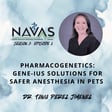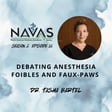
Dr. Lane Johnson Answers the Question: "Alfaxalone: Should I Be Using It?" - Ep. 14
The holiday season is in full swing and you may be asking yourself if it’s time to invest in something new for your clinic. A new anesthetic agent, perhaps? If that’s the case, then Alfaxalone may be the new drug to help shake up your old anesthetic drug protocols. Although it has been around on the veterinary market for a few years now, Alfaxalone is the newest anesthetic induction agent and with it come several interesting and intriguing potential benefits. Our guide to explore this newfangled drug is Dr. Lane Johnson, a boarded veterinary anesthesiologist, Clinical Assistant Professor of Anesthesia and Pain Management at the University of Florida, reptile enthusiast and Alfaxalone researcher. Together we will discuss how Alfaxalone came to be in its current formulation, it’s unique pharmacokinetic properties and side effects, why it’s such a great drug for sedating and anesthetizing cats and bearded dragons, and why alfaxalone has gotten its recent reputation as the best induction agent for small animals with cardiac disease. Should you purchase alfaxalone to use in your clinic? How do you use alfaxalone in the most effective and safest way possible? We hope this episode will be your guide to answering these complicated questions.
This episode is an expansion on our previous episode on Induction Agents with Dr. Xander Thomson.
In addition, check out this article by previous NAVAS podcast guest, Dr. Lydia Love, Should I Be Using Alfaxalone.
If you like what you hear, we have a couple of favors to ask of you:
Become a member at North American Veterinary Anesthesia Society (NAVAS) for access to more anesthesia and analgesia educational and RACE-approved CE content.
Spread the word. Share our podcast and FB/IG posts, re-tweet, post something on a network or a discussion forum, or tell a friend over lunch. That would really help us achieve our mission: Reduce mortality and morbidity in veterinary patients undergoing sedation, anesthesia, and analgesia through high-quality, peer-reviewed education.
If you are feeling generous this holiday season, consider donating to the NAVAS Education fund, whose mission is to improve anesthetic and analgesic care of veterinary patients by providing continuing education to veterinary professionals and caregivers. All donations help to support continuing educational efforts for veterinary professionals.
We also ask our listeners to save the date for the NAVAS Virtual Spring Symposium on April 27th and 28th, 2024. For more information about the program, visit the NAVAS Spring Symposium website. Registration starts Feb. 1.
Thank you to our sponsor, Dechra - learn more about the pharmaceutical products Dechra has to offer veterinary professionals, such as Zenalpha.
If you have questions about this episode or want to suggest topics for future episodes, reach out to the producers at education@mynavas.org.
All opinions stated by the host and their guests are theirs alone and do not represent the thoughts or opinions of any corporation, university, or other business or governmental entity.
The NAVAS Podcast is published monthly on or near the 15th of the month.
Special thanks to Chris Webster for editing, producer Maria Bridges, and Saul Jimenez for IT support in making this podcast a reality.











